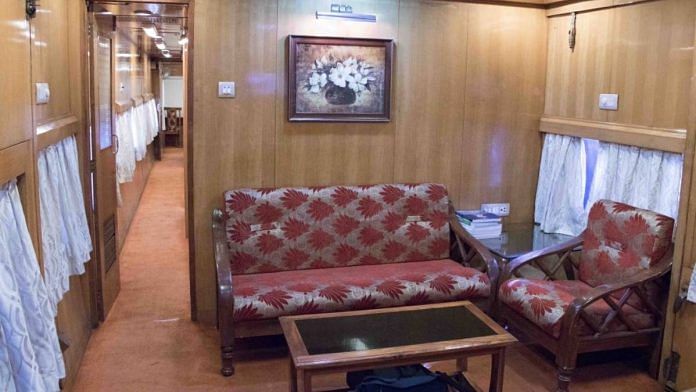New Delhi: The Rail Bhavan is learnt to have issued a fresh policy on utilisation of its luxury saloon coaches for tourism purposes, two years after it was announced by Railway Minister Piyush Goyal but failed to gain popularity.
According to railway ministry sources, the highly luxurious saloon coaches — colonial era-style carriages traditionally meant to host senior railway officers above the ranks of Divisional Railway Managers (DRMs) of zones — will be given to the Indian Railway Catering and Tourism Corporation (IRCTC) on lease at the rate of 7 per cent of depreciated capital cost of the saloon on an annual basis.
According to guidelines framed by the Indian Railways this week, the IRCTC will have to additionally pay the minimum guarantee charges of Rs 10.1 lakh per saloon per year. A minimum guarantee is the amount a producer is entitled to from the seller irrespective of how a product is received in the market.
“Only saloons which are older than 15 years are to be leased to IRCTC under this policy initially for a period of 5 years,” said the guidelines dated 14 December. ThePrint has seen a copy of the guidelines.
According to the rules, the IRCTC will be free to decide the tariff structure to be charged from tourists for the saloons.
Since these saloon cars are luxuriously furnished, the Railways clarified, “Saloon cars shall be handed over to IRCTC without the existing assets inside saloon like furniture, TV, fridge etc which may be utilized by concerned ZR (Zonal Railways) suitably like in Rest Houses, ORH (Officers Rest Houses), etc.”
The move will generate additional revenue for the national transporter, whose earnings have nosedived this year due to the Covid-19 pandemic, sources said.
Confirming the development, railway ministry spokesperson D.J. Narain said the saloon tourism plan is “in a pilot stage” at present and can be considered “part of Railway Tourism facilitation programs and initiatives of the past”.
He said this would help the Railways earn revenue without impacting any other passenger services or freight operations.
Also read: IRCTC sends out nearly 2 crore emails highlighting Modi’s relationship with Sikh community
Better response expected this time
While Railway Minister Piyush Goyal had first announced the decision to make available saloon cars in 2018, the plan did not have many takers, as very few people came forward to take these luxury coaches.
However, with the “streamlining” of the policy, the government is expecting a better response, sources said.
The Railways has a total of 336 saloon cars across railway zones. These cars are like “moving houses” with two exclusive bedrooms with attached bathroom, a large living cum dining room, a kitchenette and rear window.
“There have been cases of misuse of these coaches by officers. Traditionally, these coaches were used by senior by officers for carrying out inspections of railway tracks etc. but soon they began to be seen as colonial legacies and privileges granted to the bureaucracy,” a railway official said.
“So in that sense, the move to throw them open for public use is justified,” added the official.
The move, which is seen as taking away a colonial luxury granted to senior officers of the Railways, comes close on the heels of the Railways’ decision to stop further recruitment of bungalow peons — officially known as telephone attendant-cum-dak khalasis (TADKs) — posted at the residences of officers.
The move triggered a backlash from the railway bureaucracy, which saw the decision as unilateral.
Saloon tourism
Saloon coaches are generally used for inspection purposes and are essentially needed to reach site locations where other transport cannot be used to reach.
Previously, Narain said, luxury tourist trains such as Maharajas, Palace on Wheels, Golden Chariot, Royal Rajasthan on Wheels were operated by the Indian Railways in association with the IRCTC and state tourism corporations.
Saloon tourism is a new product being offered by the Indian Railways in the luxury segment for international or domestic travellers.
“They (the IRCTC) will develop and upgrade the saloons to luxury standards and develop tourist itineraries in line with demand of the luxury segment,” Narain said.
Each saloon can accommodate up to a maximum of 12 passengers and the coaches will be attached to suitable trains according to the itineraries decided in response to the needs of the travellers, he added.
(This report has been updated with more details on the saloon tourism plan and railway ministry spokesperson D.J. Narain’s comments)
Also read: Railways to implement plan to trim staff positions, says move won’t shrink number of jobs






